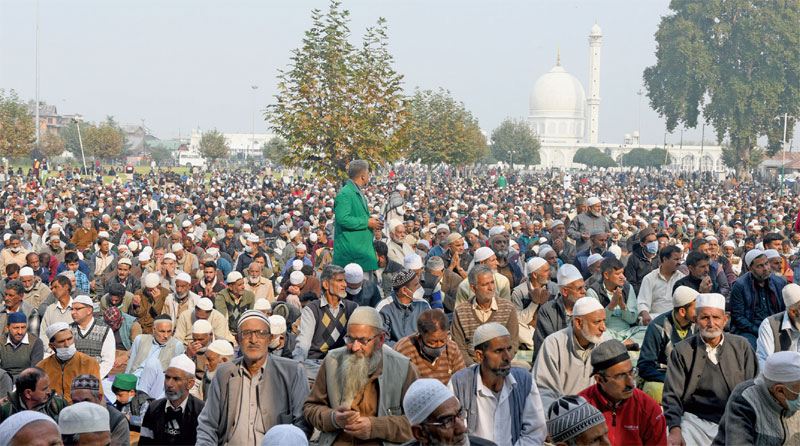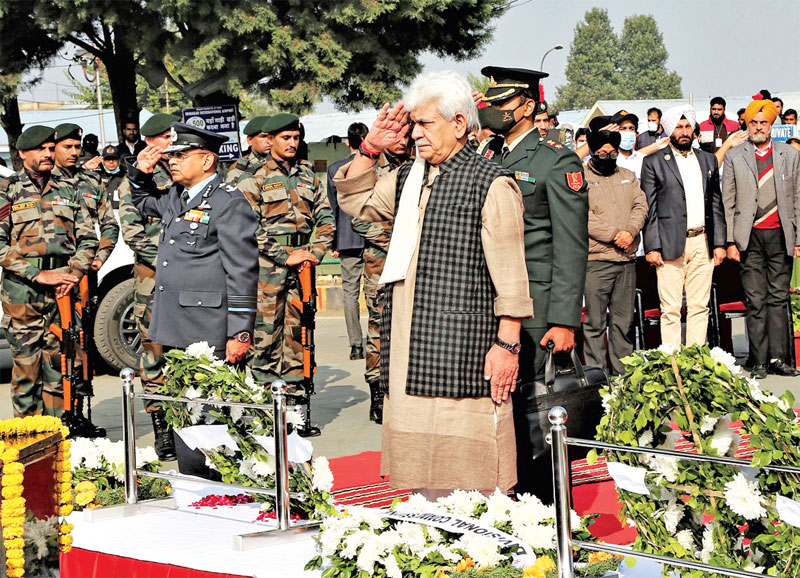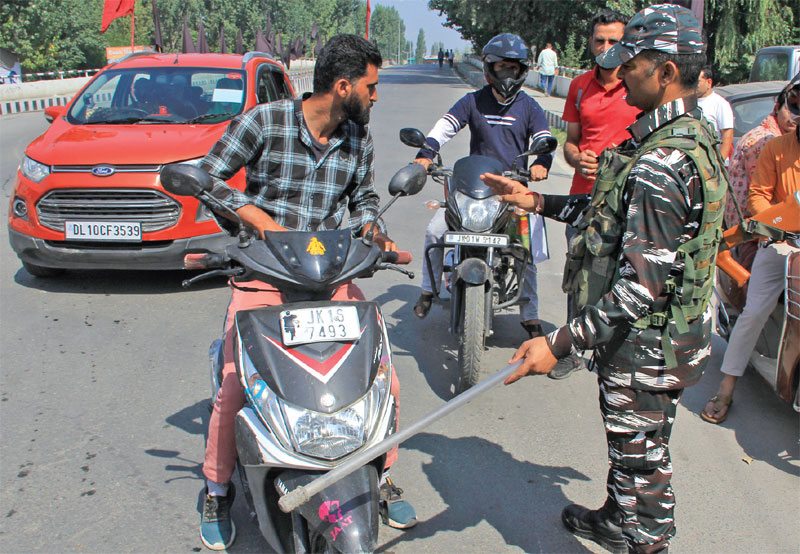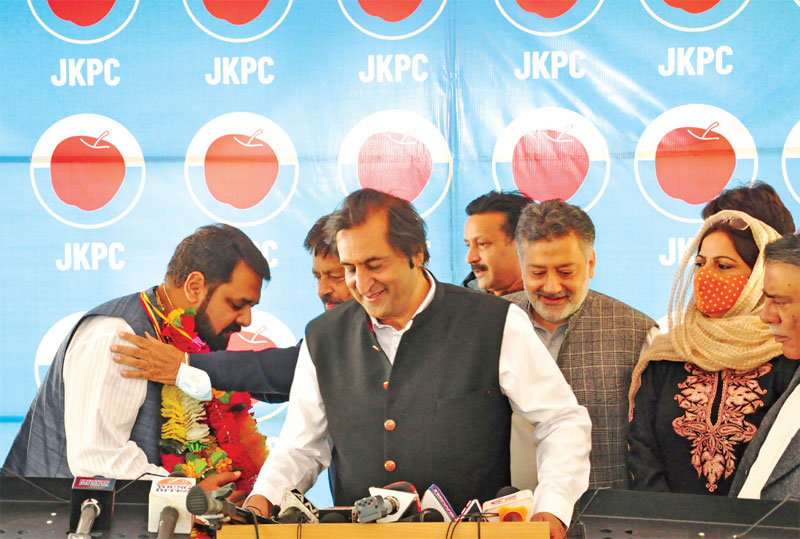Peace remains a mirage in Kashmir
Ghazala Wahab
On his maiden visit to Jammu-Kashmir since the state was reduced to a Union territory in August 2019, home minister Amit Shah told a public meeting held at Sher-e-Kashmir International Convention Centre, “I read in the newspapers today that Farooq (Abdullah) Sahab’s advice to me is that the Government of India should hold talks with Pakistan. He is an experienced leader and has been Chief Minister. It is his advice, but I want to tell Farooq Sahab and especially people here that if talks are to be held, I will speak to my brothers and sisters in the Valley, and the youth in the Valley. Why shouldn’t I speak to you?”

With that, he asked his security staff to remove the bullet proof barrier between him and the audience, comprising Bharatiya Janata Party (BJP) workers, officials from the security forces and the state administration, so that he could do some ‘mann ki baat’ with them. Shah’s confidence that none among the party workers or the state administration would try to harm him was a clear marker of his courage. A small detail though: the home minister had brought his own camera team from Delhi to capture his candid moments with his ‘brothers and sisters’. No local journalist or photographer was allowed to the event.
A day later, a few students of medicine in the university of Kashmir were booked by the state police under the anti-terror Unlawful Activities Prevention Act (UAPA) for celebrating the victory of the Pakistan cricket team over India. The action against the Kashmiri students was not limited to the Valley alone. In the days following the October 24 match, reports of detention, suspension and rustication of Kashmiri students came from states as diverse as Rajasthan and Uttar Pradesh.
Clearly, home minister’s filiality extended only to the select invitees sanitised thoroughly before the ‘public’ rally. In the days preceding the minister’s visit, all possible security details were in place—from temporary confiscation of private bikes and scooters to public demonstration of tactical unmanned aerial systems. Perhaps, to convey to the people that they were being watched.
Meanwhile, in another part of the Union Territory—the Poonch-Rajouri region, south of Pir Panjal—a deadly gunfight was underway even as the home minister was telling his audience in Srinagar how his government has ushered in an era of peace and prosperity, after fully embracing Jammu and Kashmir as its own by removing the artificial barrier of Articles 370 and 35A. Diminution of the state to the UT was merely a matter of nuance, and hence immaterial. After all, his government has brought democracy to the grassroots levels and unshackled the state from the clutches of ‘three families’—a reference to Gandhis, Abdullahs and Muftis.
The Poonch encounter was in its 13th day, even as the home minister was celebrating the end of violence. Nine army personnel had already been killed in the encounter that has been termed as one of the deadliest in over a decade and half. The most worrying aspect of this encounter has been that even after the silence of the enemy guns, there is no way of telling whether all infiltrators/ terrorists have been killed, given the topography of the area and the denseness of the forest. Some could have just slipped away.
Uncertainty is the biggest challenge in Jammu & Kashmir today. Nobody knows what is going to happen. Worse, thoughts remain uncontrolled and indecipherable. No coils of the barbed wire, no midnight crackdowns, no suspension of internet and no threats of retribution have been able to give the state a mechanism of understanding what is going on in the head of a Kashmiri—does she mean what she says, or is she saying what she means.
Insider Outsider
Post-5 August 2019, the situation has worsened. The seemingly seamless network of informers that the state police had assiduously built over the last nearly 30 years has snapped. With the lines clearly drawn between ‘us’ and ‘them’, trust is a perilous notion. The people, even former informers, do not know who they can trust in the current dispensation. Is the officer they worked with over the years trusted by his own superior or not? Or would the said officer sacrifice him at the altar of self-interest to win the trust of his superior?
The local officers also no longer trust their own network. What if the ever opportunist informer is selling contrary information to his superior or, worse, to overground workers (OGW) for more money. The one who is sitting in the market will clearly sell his wares for the highest price possible. After all, who knows how long he will be able to run his shop of information.
The source of this unsureness is the revocation of Articles 370 and 35A. That needless act of 5 August 2019 stemmed from Narendra Modi government’s compulsion of stamping its complete control over the state, removing even the illusion of self-governance. To achieve this objective of total capitulation, it employed a two-prong approach.
One, the government imposed harshest possible restrictions in Kashmir, including complete communication shutdown, effectively marooning people in their own homes for several weeks. As always, the immediate face of the government was the ground level officers who were responsible for effecting the restrictions. It is no state secret that in Kashmir, implementation of executive orders is not done through polite requests or jee janaab. The continuous curfew and police excesses committed during those weeks, further frayed the tenuous ties between the civilians and the law enforcement officials.

Two, despite the state officials doing their best to prove their loyalty to the new regime, New Delhi did not trust them. Of course, the stray incidents of some principal security officers and constables slipping away to join the ranks of the militants along with their service weapons contributed to government’s nervousness. But the main factor was the desire to upend the old order. Hence, progressively local officials were replaced by non-Kashmiri IAS and IPS officers. And overtime a perception grew in the Valley that the government was posting officials aligned not only with BJP’s ideology, but religious prejudice too.
According to a senior journalist, who does not want to be named for obvious reasons, the ratio of Kashmiri versus non-Kashmiri officers across departments is nearly 1:8. “It becomes worse with the rise in seniority,” he says. In sensitive cities, even the SSP level police officer is not a Kashmiri. The only category of Kashmiris who are found kosher are either notorious counter-insurgents with a history of extra-judicial killings or financial irregularities. Their track record is a guarantee that they are unlikely to be driven by anything except their self-interest. Also, the same track record gives the government a handle on them. The threat of enquiry and punishment keeps them on the government drawn line. Hence, officers with pending enquiries, or those who were in hiding since the 1990s because of their involvement in fake encounters have surfaced again, in advisory capacity.
The few of Kashmiri officers who remain in office have been rendered powerless despite the position. They are watched by their own colleagues, both peers and superiors. They fear being reported and fired in the ‘interest of the security of the state’. In April this year, the state administration set up a special task force to run checks on all government employees under clause 2(C) of Article 311. If the government deems an employee to be working against the interests of the state, she could be dismissed from service without any notice or opportunity to defend herself. Not only is this kind of scrutiny susceptible to subjectivity, but is also witch-hunting. But the larger impact of this is on emasculation of Kashmiri officers, the hitherto bridge between the people and the administration.
“It’s a civilisational issue now,” says the journalist who has been scrutinised and warned by the state police a few times. “While all governments in New Delhi exercised complete command and control over Kashmir, this authority was never expressed in such openly religious terms as it is being done now. The fig leaf of hearts and minds has been dispensed with totally. The majority of officers now posted in Kashmir are not only outsiders, they are hostile to the local people. And they do not pretend otherwise. It is all out in the open.”
A consequence of this was seen in June 2021. At a public function, a social activist from Ganderbal area of Srinagar, Sajad Rashid Sofi, told the advisor to the Lt Governor that since they both were Kashmiris, he could catch hold of him by his collar anytime for non-fulfilment of promises. This was the liberty he couldn’t take with officers from ‘outside who come and go.’ Though it was a public function, the conversation was private and in Kashmiri language. According to Sofi, he knew the advisor Basheer Khan and had met him thrice before.
Yet, Basheer Khan, who incidentally has several corruption cases against him and has now been shunted out of the Lt Governor’s office, chose to reply to him loudly and in Urdu. He told him that everyone present at the function was an Indian, implying that no one was an outsider. This was clearly done to attract the attention of the deputy commissioner Krittika Jyotsna. An IAS officer of the Uttar Pradesh cadre, Jyotsna was posted to Srinagar on inter-cadre deputation. Taking offence at the allegation of being an outsider, she filed a complaint against Sofi, who had to pay for his supposed intemperance by spending five days in prison.
“If one is to be kind to the young IAS officer, and believe that she was not being prejudiced against the Kashmiri man, the only other explanation for her behaviour is that she does not understand Kashmiri culture and society,” says a senior People’s Democratic Party (PDP) politician, in quasi-retirement now. “Are these the kind of officers who will win over the Kashmiri people by removing their alienation?” he asks rhetorically.

A few months later, another young officer, eager to please his bosses, displayed not just similar insensitivity but incompetence too. Syed Ali Shah Geelani, the erstwhile chairman of All Party Hurriyat Conference (APHC) and later it’s hard-line breakaway faction, APHC-G, died at 92 on September 1. The state administration determined that Geelani’s desire of being buried in the martyr’s graveyard in downtown Srinagar must not be fulfilled. In its wisdom, it thought that the place of burial accords stature to the deceased and not the other way round.
Hence, a young police officer led a posse of policemen to Geelani’s home, close to the Srinagar international airport, took control of his dead body and forcefully buried it in a small graveyard across the street against the wishes of his family. To ensure that no one attends his hurriedly conducted burial, both his house and the final resting place was barricaded. They remained so for several weeks. Rumours flew fast and thick that the police had desecrated the dead body, that it was dragged, that his protesting sons were beaten up, that they were allowed to visit the father’s grave only the following morning and under the police vigil and so on.
It is possible that most of this was not true. But when has truth come in the way of belief. No Kashmiri civilian that FORCE spoke with in the third week of September thought that any of this was untrue. By denying Geelani a place in the martyrs’ graveyard in the old part of the city, the state administration built a new martyrs’ graveyard in the new part of the city.
Did the state administration set out to humiliate Geelani in his death, and by extension the Kashmiris who looked up to him as a leader?
Unlikely. What it intended to do was avoid a spectacle that belied the myth of peace and normalcy. It sought to manage the crisis in the only way its short-sightedness allowed—bury it under the ground. It failed to realise that nothing remains buried forever, much less ideas. Sometimes they sprout in unimaginable ways.

Crisis of Management
In an asymmetric conflict, the one with more power, especially state-power, is always at a disadvantage. Power gives the illusion of physical strength, which tricks the powerful into believing that it can crush the opponent through sheer force. It doesn’t realise that the staying power of the seemingly powerless comes from its mind and its belief in the cause. Physical symbols, like weapons or graves, merely reinforce the cause, they don’t build or sustain it. Cause resides in the realm of thoughts, transmitted from people to people, generation to generation. Resistance starts with ideas, not action.
Unfortunately, the government of India, irrespective of the party, despite the experience of past several decades, have failed to grasp this simple truism. Contrary to popular perception, Kashmir has been a bi-partisan issue in India. Both the ruling Bharatiya Janata Party and its predecessor Indian National Congress are on the same page as far as the core issue is concerned. They both are committed to the idea of managing Kashmir on a day-to-day basis, instead of seeking to resolve the conflict in a permanent manner.
The only difference in the two national parties is their approach to management and dispensability of the civilian population. While the BJP has adopted a scorched earth approach (the velvet glove has been removed completely), the Congress used to balance nationalist sentiment with Kashmiri sentiment, effectively riding two horses. The end state, however, was the same: to assert complete authority over the lives of the Kashmiri people.
It would seem that this balancing act would have fooled the Kashmiris into believing that the Congress party meant well, but unfortunately that didn’t happen. In Congress’ riding of two horses, most Kashmiris saw dithering at best and duplicity at worse.
In sharp contrast, BJP’s ‘tough man’ posture conveyed decisiveness and the promise of finality. Strangely, many Kashmiris regarded this promise of finality as a good thing. In a culture where hyperbole is considered a sign of erudition, BJP’s first Prime Minister Atal Bihari Vajpayee’s rhetoric—from insaaniyat ke daayre to aar-paar ki ladai—fit right in, endearing him to the people of Kashmir as one of their kind. Straight talk, after all, is for the prosaic.
The Vajpayee legacy ensured that the average Kashmiri viewed the Modi government as a decisive force which would resolve the issue for good. Only, they didn’t understand that their perception of resolution didn’t quite match Modi governments. As a result, the revocation of Articles 370 and 35A was shock for them. The hardships that followed were debilitating. But in hindsight, the absence of the special status has not really changed anything for an average Kashmiri. What has changed everything is the erosion of everyday self-governance.
Most people knew that even though their elected state governments could not deliver on the big issues like resolution, Armed Forces [Special Powers] Act, release of political prisoners etc, they could address every day bijli, paani, sadak (infrastructure) issues. Or as Sofi told Basheer Khan, that they could catch hold of the local MLA and hold her accountable for small issues. This has changed now. The powerlessness of the old political class, howsoever venal, has left a vacuum, which the government has filled with outsiders, coached in the school of jingoistic nationalism.
This is accompanied by the dismissal of the ‘sentiment’ as ‘cross-border terrorism by Pakistan’ and of classification of militancy as terrorism. All of this has affected the lives of the Kashmiri in ways they had not imagined. The rhetoric of helplessness that fuelled the Separatist sentiment is now a lived reality. Kashmir is now an open-air prison, where everyone is a prisoner, mostly on the assumption of their ‘anti-national’ thoughts. Yet, they know that they are lucky—to be alive and still in Kashmir. Thousands of their brethren are in prisons in cities they have no access to, and hence no hope of ever seeing again. People without hope have nothing to lose. They seldom fall in line.

Dreams of the Future
Shorn of rhetoric and pretensions, the biggest example of the relationship government of India seeks with the people of Kashmir was the October 24 India-Pakistan T-20 cricket match.
In the former Mughal capital of Agra, three Kashmiri students were arrested for celebrating Pakistan’s victory over India. Charged with sedition, the students were accused of raising anti-national slogans. Once the college where they were studying clarified that no anti-national slogans were raised, it was said that they had circulated congratulatory WhatsApp messages after Pakistan’s victory. How exactly did the police got to know that the three Kashmiri students had sent congratulatory messages?
The answer lies in an obscure news item of February 2021. The Press Trust of India reported that the government of India has launched a project called Indian Cyber Crime Coordination Centre whereby it invited alert and nationalist citizens as volunteers to track anti national activities and posts on social media. Though an all-India project, the focus was Kashmir, where the pilot was launched with the police urging the citizens to register as volunteers in either of the three categories–Cyber Volunteer Unlawful Content Flagger, Cyber Awareness Promoter and Cyber Expert. No background verification of the volunteer was required for the first category. So effectively, for each Kashmiri youth, there would be a nationalist minder keeping track of her activities. It could be a purported friend or someone who wants to get even with you.
Perhaps, that’s how the congratulatory WhatsApp messages were found and cases registered. In the true nationalistic spirit, the lawyers’ association of Agra issued a directive that no lawyer would represent the Kashmiri students. The message is clear—Kashmir is an inalienable part of India; but for Kashmiri people, terms and conditions apply.
Coming to Amit Shah’s visit to Srinagar and Jammu, and his offer of talks. Who exactly can he talk with? And more to the point, talk what? The Kashmiri BJP members who had come to his rally in Srinagar? The students who celebrate Pakistan’s victory? The traders who fear loss of business by the threatened arrival of outsiders, as well as allegations of being Over Ground Workers? The parents whose children have been booked under the Public Safety Act and are incarcerated in different parts of north India? The aspiring politicians who contested and won the Block Development Council elections?
Of course, he should talk with each of them. For sure they would have a thing or two to discuss with him. But can he talk political resolution with them?
All of these, however, are rhetorical questions. The government of India has no desire, or need, to talk with anyone in Kashmir. It does not have to resolve anything, only manage. For management, it does not need to engage with the people, it only needs boots on the ground. The earlier outreach of winning over people has been replaced with striking fear in the hearts of the people. Talks about talking is good sound byte to the media, but actual talking is irrelevant.
The allocation of land to the CRPF in south Kashmir has to be seen in this context. Given the situation on the two military lines in the west and the north, the army will progressively be pulled out of counter insurgency operations in the hinterland, with the CRPF taking on more and more responsibilities along with the state police. As its deployments in the Valley assume a nature of quasi permanence, it is only fair that the force has permanent and secure accommodation for its personnel. Until now, the CRPF is hosted by the state police in semi-permanent, and often inhabitable, accommodation, including tents.
Politically, the BJP reckons itself to be in a good position in the UT. Apart from its own presence, which draws a certain number of votes in the Valley, it is supporting smaller parties, like Sajad Lone’s People’s Conference (PC) and Altaf Bukhari’s Apni Party (AP) to grow at the expense of the National Conference and the PDP, which has nearly been hollowed out. Add Congress to the mix and the votes in the Kashmir Valley will be splattered all over.
Once the delimitation is completed, the constituencies in Jammu will be aligned in the manner that in none of them Muslims will be the decisive vote. Hence, whenever the elections are held, the BJP is likely to emerge as the single largest party by a huge margin, cornering most of Jammu. With the support of parties like the PC and the AP, it will finally have the Hindu chief minister in India’s only Muslim majority region (erstwhile Muslim majority state). That would be the fulfilment of the dream of BJP’s founding fathers. Nothing else matters.
As far as demography change, settling of Kashmiri Pandits or outside investments are concerned, the government of India is not losing sleep over any of these issues. It knows that none of these are in its hands. All three of the above can only happen if there is security on the ground. In the best of times, the Kashmir Valley can only offer the security of the prison. Tourists can come to the prison to gawk at what it offers. Nobody voluntarily shifts into one.

